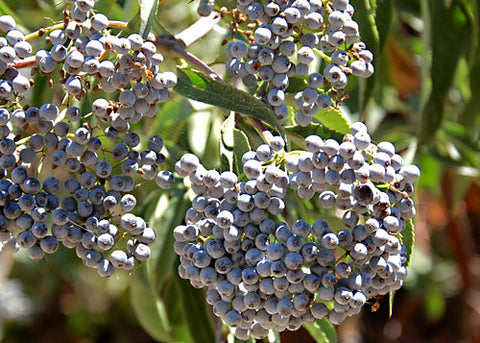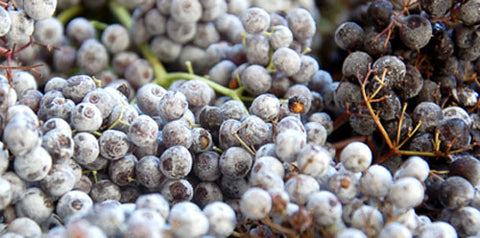Elderberries are one of the true crown jewels of wild foods. Not so very long ago, elderberries were a food that I could use to separate out the more adventurous, open-minded chefs with. If the chefs were worth their salt, they could mess about with the elderberries I provided and quickly recognize the complexity great depth of elderberries’ flavor. The port-like and cassis flavors would just astound them.
Even now, many chefs don’t have the opportunity or imagination to really go wild with this remarkable fruit. After all, elderberries are not impressive if just tasted fresh from a cluster. It takes the heat of cooking and a touch of sweetness to release their magic.

As I began today to pick a few of the early ripening clusters here in Napa, I realized that there may be an important reason they’re not recognized as the kitchen treasure they are. Elderberries HAVE to be picked when they are fully ripe, yet this isn’t at all easy for most people to figure out. Just because elderberry cluster is a gorgeous shade of deep purple doesn’t mean than the interior of the berry is fully ripe.
Most fruiting plants, erupt in flowers, go about the business of pollination and march onto the ripening of all the fruit they’re bearing. Generally this happens in a rather unified way. Apples, plums and so on get ripe en masse on a tree. Blackberries, mulberries and other berries may ripen over a few marvelous weeks. Elder trees are most peculiar however. Elderflowers will emerge in their lace-like beauty in the spring, be pollinated and then their berries form up as you’d expect. Those first early formed berries are what I’m picking through now. YET, the elder tree will just continue to produce flowers here and there on the tree for months after that first major wave of flowers. I’ve managed to gather blooming elderflowers for ice cream or panna cotta cravings as late as September! What does this matter? Well, this months’ long summer carousel of long flowering elder tree behavior leaves you facing a tree that is laden with beautiful purple clusters of berries that can as much as three months different in ripeness. The berries may all look purple on the outside but only certain clusters are ready to harvest. To the vast majority of folks picking elderberries, they all look ripe because the berries all look plump, perky and purple. The outer layer can be pretty deceptive, however.

Willy nilly elderberry harvesting is a big mistake. I know, I’ve learned the hard way. Even after I was fully aware of the amazing variation of berry ripeness on the same tree, I remember picking and thinking “Hey I’m making a savory game sauce. I don’t want them to be too ripe and sweet.” I was wrong. The sauce was thin in flavor and lacked that port-like grape/berry flavor that is the great hallmark of elderberries.
So here’s the deal. There is no real shortcut to this. Ripe elderberries have a nice purple hue to the juice as well as the skin. You’ll see the color of juice against your fingertips. The juice in unripe berries is pale and watery. As you grab a cluster, you have to squish a berry and look at the juice. This is definitely going to slow you down, but it’s worth every extra second. Once you get used to it, you can zip along with a squish and cut sort of rhythm.
Harvesting and cleaning berries:
Throughout this entire ripeness lecture, I’ve completely failed to mention the most obvious issue of all- getting clean berries off the actual elder tree. Because I harvest so many, I have settled on an efficient method years ago. This skips the loving hand labor that many folks relish, but it results in easy efficient cleaning. After finding a ripe cluster, I snip it off with scissors close to the base of the raceme. This is where are main stem separates out into the many little stems that hold the berries. I just harvest away taking whole buckets of these berry clusters home. I put these into bags and place them immediately into the freezer. After these are all frozen, take a bag out and drop it repeatedly onto a hard surface. Take a colander with large holes, or a plastic market basket with good size holes and pour the now nicely broken elderberry stem mixture into it. Put down a roasting pan or a plastic storage container and shake the colander/basket over it. The whole berries will fall through the holes leaving most of the stems behind.
If you want to go another step in cleaning the berries, place an old towel on a big cookies sheet or better yet, a section of curved drain pipe. I’ve even put a towel over the back of a lounge chair, placed a big container on the seat, draped the towel over the back of the chair and tucked the bottom of towel into the container. Whether it’s the back of a lounge chair or a cookie sheet, arrange the towel-covered surface at an ramp-like angle. Put a bowl or large container at the base of this ramp you’ve just created. Pour the berries slowly down the elevated part of this makeshift ramp. The odd bits of stem or bad berries will stick to the towel leaving the ripe round berries to round merrily into your receiving bowl. These clean berries are ready to be used, or returned to the freezer for future use.

For those who wish to suffer more for fresh berries, there’s nothing like an old fashioned fat comb or big Afro pick. You can sit and comb the fresh berries off the stems rather easily this way. What I DON’T like about this method is that the skin of really ripe berries is often torn open in the process. The delicate berry skin is often ripped in various parts when the comb pulls the berry off the stem. This can cause a significant loss of juice. Elderberry juice is what it’s all about for me. Whether you’re making jelly, sauce, wine or whatever- you want every drop of that precious juice. Whichever harvest and cleaning method you put to work, do watch carefully for genuine ripeness. Once you develop an eye, taste and the enviable passion for elderberries, you’ll find that it can be quite easy to gather significant amounts. Since more than you probably really need is out there, slow down, check the juice color and fill your buckets with the most luscious and deepest flavored berries of all. True ripeness makes all the difference imaginable.
